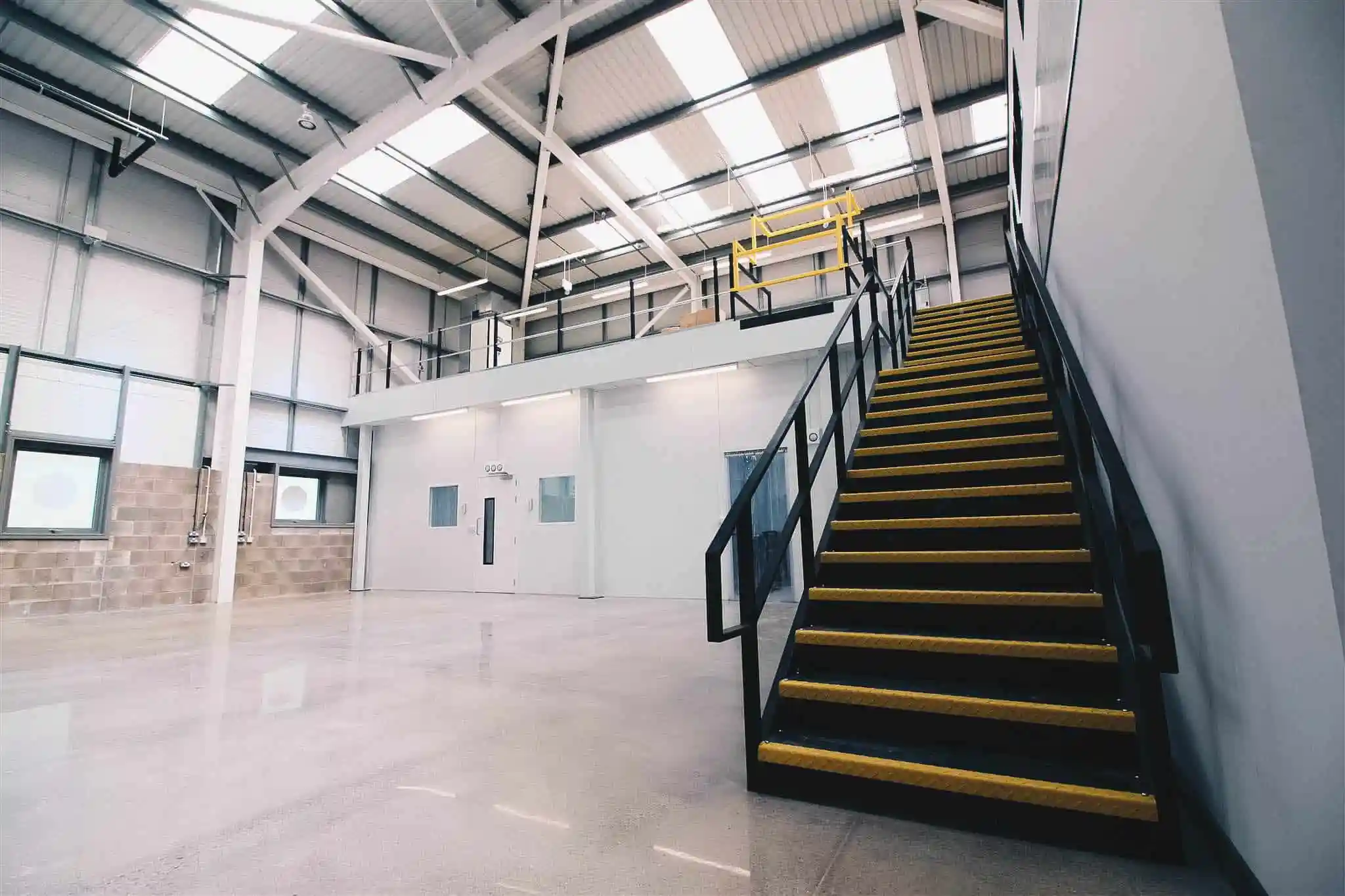In the realm of sustainable architecture, open mezzanine floors have emerged as both a striking design element and a unique energy modeling challenge. Their open design can complicate energy calculations, potentially leading to inaccuracies in predicting energy consumption. This comprehensive guide delves into the intricacies of accurately modeling open mezzanine floors in energy simulations, empowering you to create buildings that are both aesthetically pleasing and energy-efficient.
How to Treat Open Mezzanine Floors in Energy Modelling
Open mezzanine floors, with their inherent interconnectedness to the main floor, demand special attention during energy modeling. Let’s break down the key steps to ensure accuracy and optimize your building’s energy performance.
1. Divide and Conquer: Separating Thermal Zones
Imagine your mezzanine and the main floor as distinct climate zones. While physically connected, they experience heat flow and temperature variations differently. To accurately capture this in your energy model, treat them as separate thermal zones. This involves defining each zone individually within your chosen energy modeling software. By doing so, you enable the model to accurately predict how heat flows—or doesn’t flow—between these interconnected spaces.
2. Playing Detective: Hunting Down Thermal Bridges
Thermal bridges are areas in a building’s envelope where heat transfer is significantly higher due to material properties. In the case of open mezzanines, structural elements like steel beams or concrete walkways connecting to the main floor can act as thermal bridges. Failing to account for these bridges in your energy model can lead to underestimating heat loss or gain, compromising the accuracy of your simulation.
3. Let There Be (Free) Light: Maximizing Daylighting
Open mezzanine floors are inherently well-suited for maximizing daylighting—the practice of using natural light to illuminate interior spaces. By accurately modeling the size, orientation, and type of glazing (windows and skylights) on the mezzanine, you can optimize daylight penetration into both the mezzanine and the main floor. This reduces reliance on artificial lighting, significantly impacting energy savings.
4. Software to the Rescue: Automating the Heavy Lifting
Gone are the days of tedious manual calculations. Leverage the power of modern energy modeling software, specifically designed to handle the complexities of open mezzanine floors. These software tools excel at managing intricate calculations and interactions, ensuring accuracy and consistency in your results.
5. Going Pro: Advanced Techniques for the Win
For projects demanding an even higher level of precision, consider Computational Fluid Dynamics (CFD) analysis. This advanced technique simulates airflow patterns within the building, providing granular insights into the unique air circulation dynamics often present in open mezzanine spaces.
6. Reality Check: Monitoring Building Performance
Once your model is up and running, it’s crucial to validate its accuracy against real-world data. Installing building performance monitoring systems allows you to compare actual energy consumption with the model’s predictions. This data-driven feedback loop enables ongoing model calibration, ensuring its continued accuracy over time.
Why is Accurate Open Mezzanine Modeling Crucial for Building Energy Performance?
Open mezzanine floors, while architecturally captivating, present unique challenges for energy efficiency. Without accurate modeling, these spaces can become energy drains, negatively impacting a building’s overall thermal performance.
The Impact of Accurate Modeling:
- Predicting Energy Use: Accurate modeling serves as a virtual crystal ball, allowing you to predict energy consumption before construction even begins. By simulating various design scenarios, you can identify optimal solutions for maximum energy efficiency.
- Keeping Everyone Comfy: A comfortable indoor environment is paramount for occupant well-being and productivity. Accurate modeling helps achieve this by understanding and predicting airflow patterns within the open space, informing HVAC system design and placement.
- Ticking those Code Boxes: Building energy codes are becoming increasingly stringent, often requiring accurate open mezzanine modeling. By adhering to these codes, you not only ensure compliance but also contribute to a more sustainable built environment.
- Saving Money in the Long Run: Investing in accurate modeling upfront yields long-term financial benefits through reduced energy consumption. Optimized HVAC systems, informed by accurate modeling, translate to lower operating costs over the building’s lifespan.
| Benefit | Description |
|---|---|
| Predicting Energy Use | It’s like having a sneak peek into the future of your building’s energy bills. By simulating different scenarios, you can figure out how to design the space for maximum energy efficiency. |
| Keeping Everyone Comfy | Nobody wants to work in a freezing office or a sweltering apartment. Accurate modeling helps create a comfortable indoor environment by understanding how air flows in open spaces. |
| Ticking those Code Boxes | Building codes are like the rules of the construction game. Accurate modeling ensures your design is up to code, especially when it comes to energy efficiency. |
| Saving Money in the Long Run | Think of it as an investment. By optimizing the design to be energy-efficient, you’ll save money on heating, cooling, and overall energy costs for years to come. |
The Bigger Picture:
Accurate open mezzanine modeling is crucial not only for individual buildings but also for broader sustainability goals. As building codes evolve to prioritize energy efficiency, mastering these modeling techniques becomes essential. By embracing accuracy, we contribute to a future with more sustainable and energy-efficient buildings.
Key Techniques for Modeling Open Mezzanines in Energy Simulations
Now that we understand the importance, let’s explore the key techniques for effectively modeling open mezzanines:
1. Cracking the Code of Open Mezzanines: No More Heat Escape Artists!
Open mezzanines, while visually appealing, can inadvertently act as heat escape routes if not properly accounted for.
- Thermal Bridge Identification: Thoroughly analyze the structural connections between the mezzanine and the main floor to identify potential thermal bridges. Pay close attention to areas where different materials meet, such as steel beams connecting to concrete slabs.
By accurately representing these thermal bridges in your energy model, you minimize the risk of underestimating heat loss or gain, leading to more reliable energy performance predictions.
2. Let the Sunshine In: Daylighting Optimization on the Mezzanine
Daylighting is a powerful tool for reducing energy consumption while enhancing occupant comfort and well-being.
- Daylighting Optimization: Carefully model the size, orientation, and type of windows and skylights on the mezzanine to maximize natural light penetration into both the mezzanine and the main floor below.
By optimizing daylighting, you can significantly reduce the need for artificial lighting during daylight hours, leading to substantial energy savings.
3. Thermal Zoning: Creating Climate Zones for Ultimate Comfort and Efficiency
Imagine being able to customize the temperature in different areas of your home to suit individual preferences. That’s the idea behind thermal zoning.
- Thermal Zoning: Divide the open mezzanine and the main floor into separate thermal zones within your energy model. This allows you to fine-tune heating and cooling settings for each zone, optimizing thermal comfort while minimizing energy waste.
4. Software to the Rescue: Taming Complex Geometries Like a Pro
Modeling the intricate geometries often found in open mezzanine designs can be complex. Luckily, energy modeling software is here to simplify the process.
- Software Assistance: Leverage the power of energy modeling software to accurately represent complex mezzanine layouts within your model. These software tools automate complex calculations, simplifying analysis and enabling more detailed simulations.
Key Takeaways
- Hunt Down Those Thermal Bridges: Minimizing heat loss is all about identifying and accounting for those sneaky thermal bridges.
- Let There Be (Optimized) Light: Maximizing natural light through strategic daylighting design reduces the need for energy-hogging artificial lighting.
- Zone In for Efficiency: Thermal zoning allows for customized temperature control in different areas, maximizing comfort and energy efficiency.
- Software is Your Friend: Embrace the power of energy modeling software to simplify the modeling process and unlock detailed simulations for optimal building performance.
| Feature | Technique | Benefit |
|---|---|---|
| Heat Loss | Thermal bridge identification | Reduces energy waste by preventing heat escape |
| Natural Lighting | Daylighting optimization | Lowers lighting energy consumption and improves comfort |
| Temperature Control | Thermal zoning | Improves comfort and energy efficiency with targeted HVAC |
| Modeling Accuracy | Software assistance | Simplifies analysis and enables complex simulations |
(For a deep dive into energy modeling principles, check out the ASHRAE Handbook of Fundamentals, Chapter 14: Energy Modeling)
Common Open Mezzanine Modeling Mistakes and How to Avoid Them
Even with the best intentions, certain modeling mistakes can derail your efforts to accurately simulate open mezzanine floors. Let’s shine a light on these common pitfalls and how to avoid them:
1. Pretending the Mezzanine Doesn’t Exist
- The Mistake: The most fundamental error is neglecting to model the open mezzanine altogether. This oversimplification renders your energy analysis meaningless, as it fails to account for the unique energy dynamics of these spaces.
- The Solution: Always model the open mezzanine as a distinct element within your energy model, ensuring it’s not treated as a mere extension of the main floor.
2. Forgetting About the VAV
- The Mistake: Variable Air Volume (VAV) systems, commonly used in commercial buildings, adjust airflow based on occupancy and temperature requirements. Failing to properly integrate VAV system dynamics into your model, especially regarding the mezzanine, can lead to inaccurate airflow and energy consumption predictions.
- The Solution: Carefully model the VAV system’s impact on the mezzanine, considering factors like diffuser locations, airflow rates, and control strategies.
3. Overestimating Cooling Needs
- The Mistake: Open mezzanines, due to their elevated position and potential for natural ventilation, often require less cooling than enclosed spaces. Overestimating cooling loads can result in oversized HVAC systems and wasted energy.
- The Solution: Accurately factor in natural ventilation potential by considering factors like window openings, ceiling heights, and prevailing wind patterns.
Wrapping It Up
Modeling open mezzanines doesn’t have to be a daunting task. By understanding the common pitfalls and embracing the techniques outlined in this guide, you can achieve accurate energy models that lead to more energy-efficient and comfortable buildings. Remember, accurate modeling is an investment that pays dividends in the form of lower energy bills, happier occupants, and a more sustainable future.
Additional Insights
- Integrated Energy Modeling: Strive to integrate energy modeling throughout the entire building design process, from the initial conceptual phase to post-occupancy evaluation. This iterative approach ensures that energy efficiency remains a top priority at every stage.
- Advanced Modeling Techniques: Explore emerging modeling technologies like Computational Fluid Dynamics (CFD) analysis. CFD simulations provide granular insights into airflow patterns within open mezzanine spaces, enabling highly optimized designs.
- Building Performance Monitoring: Consider implementing building performance monitoring systems to gather real-world data on energy consumption. This data can then be used to validate and fine-tune your energy models, ensuring continued accuracy over time.
By embracing these additional insights and continuously refining your modeling techniques, you can stay at the forefront of sustainable building design and contribute to a greener built environment.
Wondering what is the exact meaning of mezzanine floor in tamil? Follow this link to know more about it. Or, want to know what is the legally accepted height of a mezzanine? Then here is an informative article for you. Also, if you are interested in more about mezzanine finishing for residential, check out this article.
- Kitchen tiling wall: Elevate your kitchen with stylish wall tiles - December 16, 2025
- Gray Kitchen Backsplash Tile: Ideas for a Stylish Upgrade - December 14, 2025
- Backsplash For Gray Cabinets: Choosing the Right Backsplash Style - December 13, 2025









